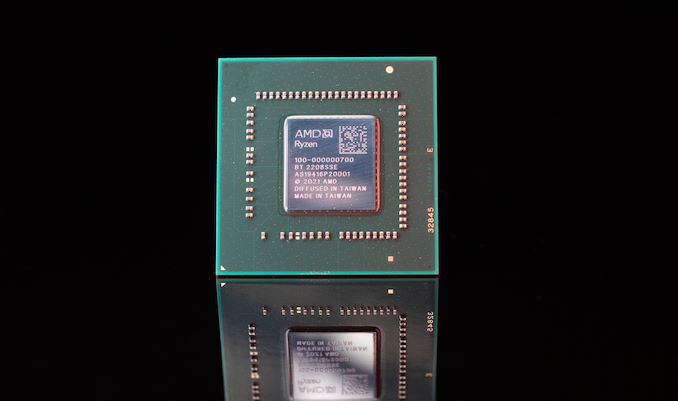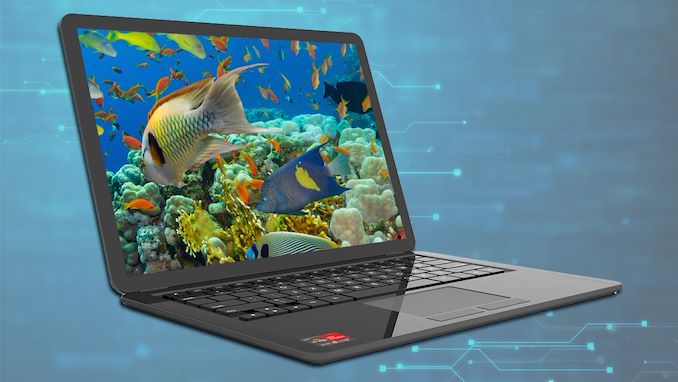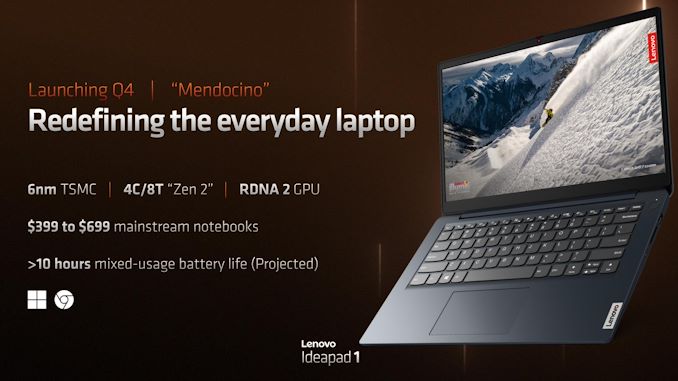AMD Launches Mendocino APUs: Zen 2-based Ryzen and Athlon 7020 Series with RDNA 2 Graphics
by Gavin Bonshor on September 20, 2022 3:00 PM EST
Even though the main focus this month has been on AMD's upcoming launch of its Ryzen 7000 desktop series processors based on the Zen 4 architecture, AMD is also in the process of launching its 7020 series of processors designed for entry-level mobile, codenamed Mendocino. It has launched four new SKUs for mobile, including two Ryzen series models and two Athlon variants, all based on its Zen 2 architecture.
As we learned in May, AMD's Zen 2 based 'Mendocino' APUs are designed as part of its lower-end mobile processor stack for entry-level thin notebook and laptop solutions. The affordable APUs incorporate up to 4 Zen 2 CPU cores, as well as AMD's integrated Radeon 610M graphics, all with a maximum TDP of 15W.
Focusing specifically on the AMD 7020 series APUs announced today, the top SKU is the Ryzen 5 7520U. Using AMD's new Ryzen Mobile CPU numbering system, the 7520U is a model year 2023 chip under the Ryzen 5 series banner using its Zen 2 core architecture. The U suffix technically means 15-28W, but in this case AMD has confirmed that all of the current chips have a max TDP of 15W.
The AMD Ryzen 5 7520U benefits from a 2.8 GHz base frequency across its four cores, with a 1T boost frequency of up to 4.3 GHz. It also includes a total of 6MB of cache, split between 4MB of L3 and 2MB of L2 (512KB per core).
| AMD Ryzen 7020 Series (Mendocino) Lineup | ||||||
| SKU | Cores/Threads | CPU Frequency (Base) |
CPU Frequency (1T Boost) |
Cache | iGPU | TDP |
| Ryzen 5 7520U | 4C / 8T | 2.8 GHz | 4.3 GHz | 2MB L2 + 4MB L3 | Radeon 610M | 15 W |
| Ryzen 3 7320U | 4C / 8T | 2.4 GHz | 4.1 GHz | 2MB L2 + 4MB L3 | Radeon 610M | 15 W |
| Athlon Gold 7220U | 2C / 4T | 2.4 GHz | 3.7 GHz | 1MB L2 + 4MB L3 | Radeon 610M | 15 W |
| Athlon Silver 7120U | 2C / 2T | 2.4 GHz | 3.5 GHz | 1MB L2 + 2MB L3 | Radeon 610M | 15 W |
Moving down the stack is the Ryzen 3 7320U, which has four cores and eight threads but a base core clock speed of 2.4 GHz and a single core boost frequency of up to 4.1 GHz. Like the Ryzen 5 7520U, it also benefits from a combined cache of 6 MB across its L2/L3 cache structure.
Looking at the Athlon-branded 7020 series chips, the Athlon Gold 7220U offers two cores and four threads, with a base frequency of 2.4 GHz, a single core boost frequency of up to 3.7 GHz, and 5 MB of shared L2/L3 cache. The Athlon Silver 7120U is pretty much the Athlon Gold 7220U, but it has a slightly lower 1T boost frequency of 3.5 GHz, no simultaneous multithreading (SMT) support, and half as much L3 cache (for a total of 3MB instead of 5MB)

AMD Radeon 610M with two graphics cores for performance at the entry-level
All of today's announced AMD's Zen 2 Ryzen and Athlon 7020 series will support up to 32 GB of LPDDR5 memory in a dual-channel (64-bit) configuration, and feature two graphics cores/CUs based on its RNDA 2 technology, which AMD is branding the Radeon 610M integrated graphics chip. All four mobile APUs will also include a TDP of up to 15 W.
At the time of writing, AMD hasn't revealed specific pricing aside from a total laptop price range of between $399 and $699. However, it has announced that its AMD Ryzen 7020 Series Ecosystem partners are Acer, HP, Lenovo, and Microsoft, with notebooks featuring these chips expected to start appearing on retail shelves sometime in Q4 2022.
Source: AMD











49 Comments
View All Comments
shabby - Tuesday, September 20, 2022 - link
Pathetic, naming all cpus as 7000 series, without a chart newbies can't tell these apart if they're good or old junk.Tom_Yum - Tuesday, September 20, 2022 - link
Why does the specific architecture of the core (which is a small part of the larger platform) matter to the average consumer? What matters is how it stacks up against competitors which for Intel are the Celeron/Pentiums (soon to just be 'Intel Processor'). With LDDR5 and RDNA2 graphics it is modern from a feature set perspective within its market segment.ballsystemlord - Tuesday, September 20, 2022 - link
Because it tells you what sort of single threaded performance to expect. # Cores, # Threads, # Frequency/GHz, # Arch.Now we know it all. I welcome this much needed change.
Tom_Yum - Tuesday, September 20, 2022 - link
I agree with the change in naming making it clearer. I just struggle to understand why people would refer to it as 'old junk' like the architecture in isolation matters. Hence why I said what matters is how it stacks up again it's competitors like the Intel Celeron and Pentiums. Knowing it is Zen 2 makes it easy for us tech enthusiasts to estimate performance, but for the general comsumer all they care is whether it is faster than that similarly priced laptop over there rocking an Intel Celeron.ballsystemlord - Tuesday, September 20, 2022 - link
But even with a brilliant naming scheme, that question cannot be answered so easily.Exhibit A: The 1090T Phenom II 6-core processor and it's Intel counter part.
At the time, the Intel part was ahead in single threaded workloads, very far ahead. But for mutli-threaded ones it was behind, far behind. What number do you propose to show where each belongs?
As the processors aged, the Intel part fell by the wayside, so much so that I can't even recall it's number or name. But the 1090T, according to my experience and at least one review I read on newegg, continued to work like a power horse for 8+ years through till almost today. How would you categorize something with such compute longevity? Surely it was the better buy even if it operates slowly, then and today?
Now that we have iGPUs, it's even tougher to name things because you have to take into consideration the CPU AND the GPU.
Robert Pankiw - Monday, September 26, 2022 - link
That's a blast from the past for me. My first self built machine used that very Phenom. When I saw the performance that Bulldozer was offering, I was less than impressed. Part of me really misses that old thing. I sold it long ago though, and as far as I can recall, the friend who bought it off of me was quite happy with it for a few years. That was all well before Ryzen was ever a thing.StevoLincolnite - Monday, October 3, 2022 - link
Had the 1090T myself... Sadly I wanted more single threaded performance so I ended up upgrading to the Intel 3930K.Now currently with the Ryzen 5950X.
The 1090T was a great chip for the time, was even a better chip than the first gen bulldozers in many respects.
shabby - Tuesday, September 20, 2022 - link
You must work for marketing...meacupla - Wednesday, September 21, 2022 - link
Do you have a short memory?AMD has a history of selling Zen2 parts right along side Zen3 parts, in the same 5000U series.
lightningz71 - Wednesday, September 21, 2022 - link
Arguably, the 5000U naming system did make at least relative sense, even if they included different generations of core. The Lucienne "odd" numbered parts were arguably better than the next lower "even" numbered Cezanne parts in multiple ways. For example, the 5700U had 8 cores as opposed to the 6 of the 5600u, as well as having an additional Vega CU over the 5600u. In benchmarks, it wasn't far behind the 5600u in single thread situations and was near universally faster in multi-thread situations where N>6.This new schema though, unless you've memorized the naming scheme, your SOL for being able to figure out value and performance without having to sit down and research what you're looking at.